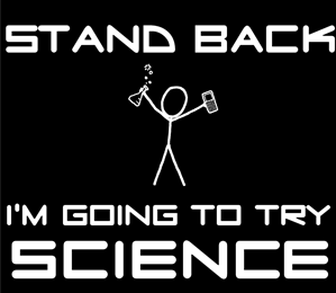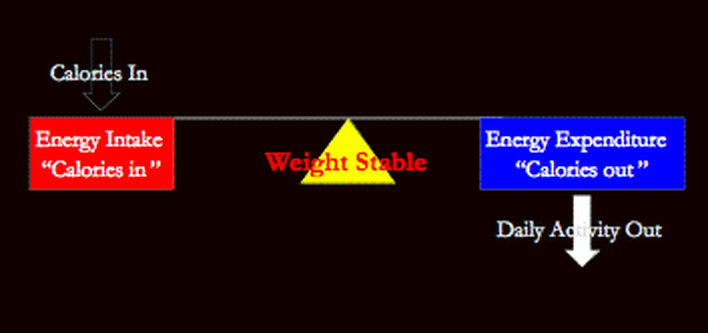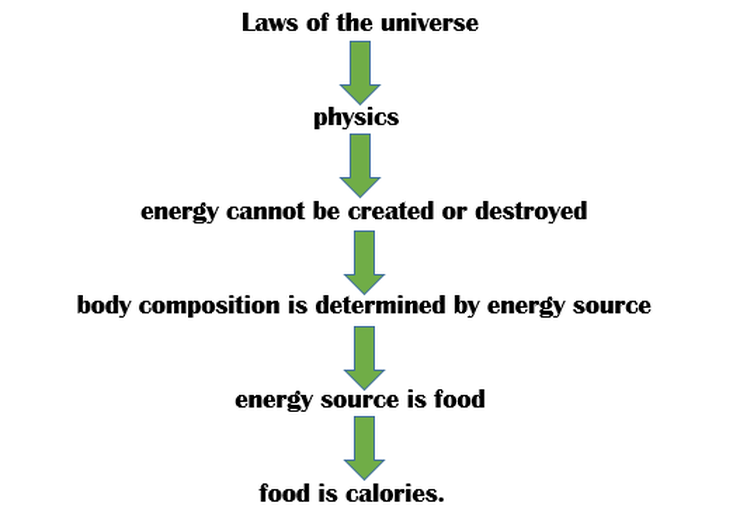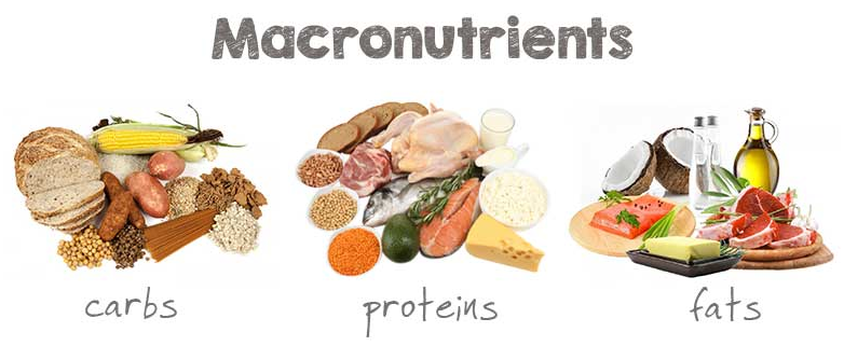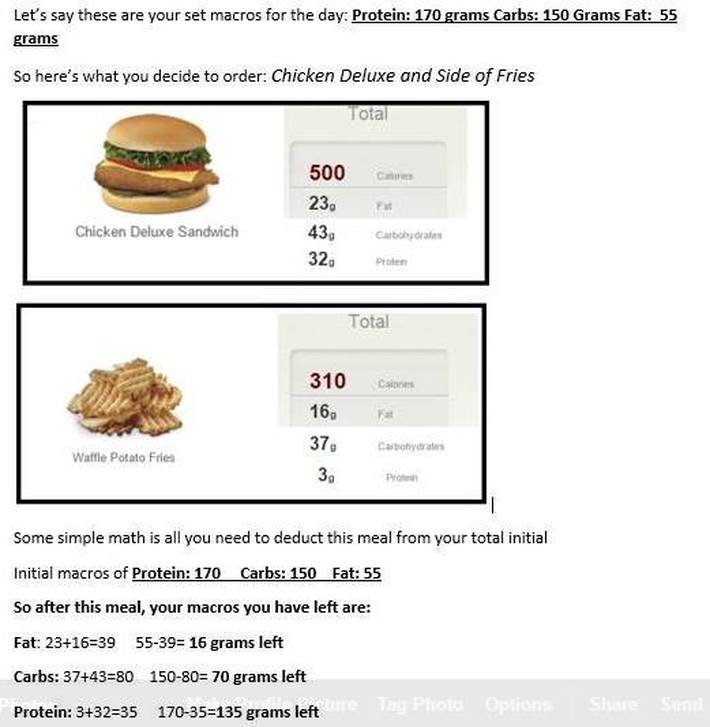It’s become such a regular thing for both people that I know and people who find me online to ask something along the lines of “I get the concept of tracking macros, but how do I get started?”
Getting started doing something is often the hardest part when you want to tackle something new.
Starting something new is “hard” because it’s unfamiliar and takes some effort and can sometimes make us feel unsure about what we’re diving into, or even worse, make us feel dumb.
I want to get as many people as I can to start tracking macros and counting calories at some level, but trying to talk people into counting calories and counting macros by making it seem like it’s a miracle program isn’t what I’m about. I put the information out there and those who are willing to take the first step and decide they want to make a really positive change to their lives will seek more information, or hopefully approach me about it.
And that’s what I’m here to do with this article.
This is going to be a short and sweet crash course tutorial about what you need to know about tracking macros and how the process works.
For those reading who may not know too much about tracking macros, it’s also referred to as “flexible dieting” and “if it fits your macros” dieting.
In my opinion, those names seem to give the concept of tracking macros a gimmicky feel and it can get categorized as a fad diet with the likes of Paleo diets, Adkins diets, low carb diets, and cleanses.
Here’s the fact of the matter: It’s a truly scientific approach.
Science.
Yup, actual science. I’m not going to get you all bogged down on the technical details of it, but I will explain how the laws of physics impact your body and the way you look and feel.
Getting started doing something is often the hardest part when you want to tackle something new.
Starting something new is “hard” because it’s unfamiliar and takes some effort and can sometimes make us feel unsure about what we’re diving into, or even worse, make us feel dumb.
I want to get as many people as I can to start tracking macros and counting calories at some level, but trying to talk people into counting calories and counting macros by making it seem like it’s a miracle program isn’t what I’m about. I put the information out there and those who are willing to take the first step and decide they want to make a really positive change to their lives will seek more information, or hopefully approach me about it.
And that’s what I’m here to do with this article.
This is going to be a short and sweet crash course tutorial about what you need to know about tracking macros and how the process works.
For those reading who may not know too much about tracking macros, it’s also referred to as “flexible dieting” and “if it fits your macros” dieting.
In my opinion, those names seem to give the concept of tracking macros a gimmicky feel and it can get categorized as a fad diet with the likes of Paleo diets, Adkins diets, low carb diets, and cleanses.
Here’s the fact of the matter: It’s a truly scientific approach.
Science.
Yup, actual science. I’m not going to get you all bogged down on the technical details of it, but I will explain how the laws of physics impact your body and the way you look and feel.
You know, physics and stuff.
Everything in this universe abides by the laws of physics and the energy balance equation, there’s no arguing that.
Trying to say the energy balance equation isn’t real goes along the lines of saying gravity isn’t real.
If you want to argue any of these facts then you have no business reading the rest of the post, and honestly you have no business reproducing on this planet. Sorry to come off a bit harsh here but it’s for the sake of the survival of the human race.
So continuing on, the human body is a highly mechanical machine with hundreds, if not thousands of individually working systems that provide second to second feedback and adaptations. That’s about as deep as I’ll go into that.
In order for our body to function on a daily basis it needs energy.
And as I hope you all may know, energy cannot just be created or destroyed (physical law of thermodynamic), hence the human body needs an external source of energy to be put in.
Where does this energy come from then?
You may be thinking there’s energy stored within the body, and that’s true, but it didn’t just magically appear. It’s energy from food sources, also known as calories.
What’s important to know here is that your body is constantly in a process of gaining and losing energy at any given time. Even as you sit here reading this, you’re in a state of energy loss because your body is consuming stored energy to help you breathe, see, think, etc.
Everything in this universe abides by the laws of physics and the energy balance equation, there’s no arguing that.
Trying to say the energy balance equation isn’t real goes along the lines of saying gravity isn’t real.
If you want to argue any of these facts then you have no business reading the rest of the post, and honestly you have no business reproducing on this planet. Sorry to come off a bit harsh here but it’s for the sake of the survival of the human race.
So continuing on, the human body is a highly mechanical machine with hundreds, if not thousands of individually working systems that provide second to second feedback and adaptations. That’s about as deep as I’ll go into that.
In order for our body to function on a daily basis it needs energy.
And as I hope you all may know, energy cannot just be created or destroyed (physical law of thermodynamic), hence the human body needs an external source of energy to be put in.
Where does this energy come from then?
You may be thinking there’s energy stored within the body, and that’s true, but it didn’t just magically appear. It’s energy from food sources, also known as calories.
What’s important to know here is that your body is constantly in a process of gaining and losing energy at any given time. Even as you sit here reading this, you’re in a state of energy loss because your body is consuming stored energy to help you breathe, see, think, etc.
Conversely, the times you are eating and digesting food (calories) your body is in a state of gaining by storing the energy coming in for a later period.
I’m going to try and be as clear as I can with this next part, because it’s the fundamental physical law that will determine whether you’re gaining (body weight, mass, fat, etc) or losing.
If you consume more energy than your body expends in a given period, you will gain. This can also be expressed as if you expend less energy than you consume, you will gain.
The opposite of this is if you expend more energy than you consume in a given time frame, you will lose body mass. Another way to express it would be if you consume less energy than you expend you will lose body mass.
So what does this mean exactly?
This means that CALORIES COUNT.
If you’ve followed the logic to this point, then there’s no arguing this fact.
There’s the logical flow chart.
But even with the logic laid out, there will still be a camp out there that strongly believes that “if you only eat clean and healthy foods, you’ll lose weight because they’re healthy.”
And of course you know the success stories of people who only ate a certain way and lost 20 to 50 pounds because of the magical benefits of their certain diet or food choices.
But their success did not come directly from these food choices or restricting certain foods, eating at certain times, or working out a certain way.
Whether they know it or not, they were adhering to the principles of physics and the energy balance equation.
By restricting foods and eating only certain types of foods, they were consuming less energy than what they’re body has been adapted to.
Everybody has what’s known as a “maintenance calories” set point, and everybody’s is different. When calories are met at a maintained level, there is no increase or decrease in body mass (weight).
Once you begin to eat below this maintenance calorie level, you will see a decrease in body mass; depending on how severe this deficit is between the maintenance level and the calories that are being consumed.
So THIS is exactly why people who find success without counting calories or tracking macros actually have that success.
Because the calories matter.
So what do macros have to do with Calories?
Well, thank you for asking, and here’s where this stuff gets fun.
The term Macro is short for Macro-Nutrient. So what are macros exactly?
There are only 3 major macronutrients which are protein, carbohydrate, and fat. Technically, alcohol is a 4th macronutrient but that’s beyond the scope of what we’re trying to cover today.
Each of these macronutrients have stored energy within them and are utilized by the body for physical energy.
The calorie content of each macronutrient has been tested and proven to be as such:
1 gram of protein = 4 calories
1 gram of carbohydrate = 4 calories
1 gram of fat = 9 calories
This is how we can determine calories from macronutrients and vice versa.
Again, this isn’t me making up some arbitrary point system and attributing energy values to macros to develop a gimmicky program- this is physical energy.
Being in an energy deficit or surplus will change the stored energy within the body, and as I hope you can infer by now that if you’re in a deficit you’ll lose body mass, and if you’re in a calorie surplus you’ll gain body mass. It’s a simple principle but there’s more to it.
If you only consumed 2000 calories worth of carbohydrate, your results and body composition would be different than if you consumed 2000 calories of protein exclusively.
I’ll explain why right now.
Let’s talk about the Macros
Protein- Protein is primarily used in the body for repair and maintenance of muscle and other organic tissue. It’s comprised of amino acids which your body uses for said maintenance. It’s not a first source of mechanical energy for the body, but can be used for this when other energy sources (carbs, fats) are extremely low or non-existent.
Carbs- While not the preferred energy source by the body, carbs do provide adequate energy by being broken down into glucose during digestion and stored in the body’s muscles and organs as glycogen for readily available energy when necessary. When this glycogen is low in the body and you remain below maintenance calories, there’s NO problem with consuming carbohydrates because they will be utilized and stored in the body appropriately. Carbs will only “make you fat” if your glycogen levels are at capacity and you’re consuming calories above your maintenance level. I’ll repeat that. You have no reason to be afraid to eat carbs. They don’t instantly make you fat and they are a great source of energy. I’ll leave it at that for now.
Fat- Dietary fat is the primary energy source that the body prefers to use. The human body doesn’t need carbohydrate to survive, but it does require dietary fat for survival. Fat often gets a bad rap because people seem to think that eating dietary fat will make you gain body fat. This isn’t true. There’s no such thing as eating any type of macro nutrient or type of food that will instantaneously make you fat. This only happens when calories exceed a maintenance level.
Protein- Protein is primarily used in the body for repair and maintenance of muscle and other organic tissue. It’s comprised of amino acids which your body uses for said maintenance. It’s not a first source of mechanical energy for the body, but can be used for this when other energy sources (carbs, fats) are extremely low or non-existent.
Carbs- While not the preferred energy source by the body, carbs do provide adequate energy by being broken down into glucose during digestion and stored in the body’s muscles and organs as glycogen for readily available energy when necessary. When this glycogen is low in the body and you remain below maintenance calories, there’s NO problem with consuming carbohydrates because they will be utilized and stored in the body appropriately. Carbs will only “make you fat” if your glycogen levels are at capacity and you’re consuming calories above your maintenance level. I’ll repeat that. You have no reason to be afraid to eat carbs. They don’t instantly make you fat and they are a great source of energy. I’ll leave it at that for now.
Fat- Dietary fat is the primary energy source that the body prefers to use. The human body doesn’t need carbohydrate to survive, but it does require dietary fat for survival. Fat often gets a bad rap because people seem to think that eating dietary fat will make you gain body fat. This isn’t true. There’s no such thing as eating any type of macro nutrient or type of food that will instantaneously make you fat. This only happens when calories exceed a maintenance level.
How to break down Macros into percentages
As I stated earlier, even if you abide by the energy balance and consume your maintenance calories, your body composition will be drastically different if you consumed strictly protein versus strictly carbs or fats.
For further clarification, protein is predominantly used for muscle maintenance and repair, while carbs and fat are energy. Repeat that to yourself so it sticks.
A lot of the popular fad diets want you to restrict an entire group of macronutrients, often villainizing them as foods that make unhealthy or make you fat.
Here’s the key to a successful diet, are you ready?
A successful diet is one that is sustainable and that you can adhere to indefinitely. If you can’t see yourself eating a certain way continuously for 2 years, then the diet will fail you.
All diets will work when you restrict calories below maintenance level, that’s not the issue. The issue is what happens when the diet is over and you go back to eating the way you used to.
You’re going to regain all of that weight and then some.
It’s unrealistic to think you can go your whole life without eating carbs, or eating fast food, or eating only protein or whatever some of these diets want you to do.
The best plan is to incorporate protein, carbs, and fat into a diet plan based on total calories
What this means is diving up your total daily calories amongst the 3 macros.
Some plans that use macros may advise basing these macros on a percent basis, but there’s a major flaw there. When total calories begin to be increased or reduced, the percentages will become skewed so it’s best just to assign individual values for each macro and increase or decrease accordingly.
I’ll lay out a quick example, and remember its ONLY AN EXAMPLE. Don’t try to take these values and apply them to yourself because your body composition is completely different from what I’m basing this on. The concept would be the same, but the numerical values would be different.
There’s also the fact that the percentages and/or values change depending on the goal. The macros would be different for the same person when trying to lose body fat versus trying to add lean muscle mass.
So let’s say we have a young male who’s trying to increase his lean muscle mass while limiting as much fat gain as possible (sidenote: when in a calorie surplus you will gain bodyfat along with muscle mass. We’ll get more into this down the line)
This young male has trained with weights for about a year and made some decent “noobie” gains, but now feels it’s time to up the ante.
Based on his training level and current body composition including overall body weight, body fat, and final goal composition, we can figure out his total daily maintenance calories.
There’s several different ways to do this, but for the sake of time I’ll just provide the numbers. If you’d like to find out how to set your own calories, there’s lots of information online to do this. One method I like to use the Kache-McCardle equation.
So for this example, this young man’s daily calories to maintain his current physique are 2900 calories.
Because he wants to see an increase in lean muscle mass, we need to put him in a calorie surplus.
This means increasing these daily calories by 500, so we’re looking at a daily calorie intake of 3400 calories.
The reason we increased by 500 calories was to make sure he doesn’t gain body mass at a substantial rate, because although he will increase lean muscle, the likelihood of increasing body fat is higher when more calories are consumed.
Anything less than 500 might not be enough to see considerable improvement.
Now let’s figure out these macros based on the calories.
One rule of thumb when gaining lean muscle mass or “bulking” is to set your protein value to 1 gram of protein per pound of bodyweight. For most trainees, this is a safe bet.
So this young man weights 180 lbs, so his protein will be set at 180 grams. Easy, right.
Now we multiply 180 x 4 , which gives us 720 calories.
Subtract these 720 from 3400 and we’re left with 2680 calories.
We’ll get back to these remaining calories in a minute, but right now let’s figure out this person’s fat intake.
During a gaining phase or “bulk” carbohydrates will be emphasized the most, but fat is still crucial, but because carbs will be set a bit higher, then the fat can be set to a lower value to compensate.
SO in ithis instance, about 90 grams of fat will be sufficient.
Now we multiply this 90 grams by 9 (remember, fat is 9 calories per gram) and we get 810 calories.
Subtract this 810 calories from 2680 and we’re left with 1870 caloires.
Here is where we can figure out the remaining carbohydrates that must be consumed to meet this surplus calorie value.
Here is where we’ll take the remaining 1870 calories and divide them by 4 calories/gram of carbs, and this gives us 467 grams of carbohydrates.
And that is how it’s done.
In this instance, this person’s macros will look like this:
Protein= 180 grams
Fat= 90 grams
Carbohydrate= 467 grams
Total Calories= 3400
Please remember that is a loose example just to demonstrate how to calculate macronutrients from calories. A persons maintenance calories and macronutrient values/ratios will all be based on that person’s individual body type and goals.
Specific Body Composition Goals
Everybody has their own idea how how they ideally want to look, and that’s perfectly fine. The problem here is that a lot of people attempt to reach these goals with the wrong information.
People tyring to add lean muscle mass will have a very hard time doing so if they don’t include carbohydrates in their diet. So if you want to pump up a bit, it’s not going to happen eating a low calorie paleo diet.
The same goes for losing body fat. It’s not going to happen if your protein consumption isn’t adequate and your piling down loads of fruits and whole grains because you’ve been told they’re “healthy.”
Quantifying these macros and having a metric to base them on is the best course of action, trust me on this.
Very briefly, I’ll explain a few different macronutrient breakdowns that can be utlitized for specific goals.
Purely Fat Loss- Fat loss ins’t complicated. I hope you can see that all it takes is a calorie deficit and you’ll begin to lose body mass, which we want to be almost 100% body fat. Being in this calorie deficit will instill fat loss, but we want to preserve lean muscle mass along the way to help the body function it’s best and to also look good as well. The best way to do this is to make sure you’re getting adequate protein DAILY. This means a minimum of 1 gram per body weight, and in more aggressive fat loss cases, protein should be increased to 1.5 grams per body weight. Fat should be kept at a moderate amount, usually around 30% of total calories. This is not an absolute! But it’s a pretty solid recommendation if you need a jumping off point. The last part to configure would be the carbohydrates, which can either be figured out like we did in the example above, or be set initially around 40% to 50% of total defecit calories.
Increase Lean Muscle Mass- This will look very similar to the example outlined above. Because calories will be at a surplus to increase body mass, protein does not need to be extremely high, but adequate amoutns are required. This means around 1 gram of protein per pound of bodyweight. To mitigate an increase in bodyfat while being in a surplus, dietary fat consumption doesn’t need to be extremely high. Around 35-40% of total daily calories is usually adequate, or around 70-90 grams of fat for most people. And as you can probably infer by now, carbohydrates will be figured from the remaining calories after computing the protein and fat calories from macros.
Increasing lean body mass while losing body fat- This is what’s known as a body re-composition, and this is a tricky scenario. It’s not impossible to do both simultaneously, but it’s often not realistic. For most people who are new to weight training and dieting, they will be very capable of doing both…for a while. The body will ultimaly adapt to the training and dieting and progress will slow. For most people who have been training for several years won’t have much success with this approach. The rate of fat loss will be quite slow and the rate of an increase of lean muscle mass will be even slower. While progress might occur, it won’t be visible for quite some time. The best bet is to either be in a calorie surplus to add an increase in muscle mass, OR be in a calorie deficit to lose body fat while retaining lean muscle mass. Typically there is some type of calorie and/or carbohydrate cycling that goes along with this type of plan. This might mean eating lower calories during the week to be in a deficit and ensure fat loss, and then eating higher calories on the weekend (mostly carbohydrates) to be in a short surplus and ensure proper muscle recovery and muscle growth. It’s tricky, but not impossible.
Everybody has their own idea how how they ideally want to look, and that’s perfectly fine. The problem here is that a lot of people attempt to reach these goals with the wrong information.
People tyring to add lean muscle mass will have a very hard time doing so if they don’t include carbohydrates in their diet. So if you want to pump up a bit, it’s not going to happen eating a low calorie paleo diet.
The same goes for losing body fat. It’s not going to happen if your protein consumption isn’t adequate and your piling down loads of fruits and whole grains because you’ve been told they’re “healthy.”
Quantifying these macros and having a metric to base them on is the best course of action, trust me on this.
Very briefly, I’ll explain a few different macronutrient breakdowns that can be utlitized for specific goals.
Purely Fat Loss- Fat loss ins’t complicated. I hope you can see that all it takes is a calorie deficit and you’ll begin to lose body mass, which we want to be almost 100% body fat. Being in this calorie deficit will instill fat loss, but we want to preserve lean muscle mass along the way to help the body function it’s best and to also look good as well. The best way to do this is to make sure you’re getting adequate protein DAILY. This means a minimum of 1 gram per body weight, and in more aggressive fat loss cases, protein should be increased to 1.5 grams per body weight. Fat should be kept at a moderate amount, usually around 30% of total calories. This is not an absolute! But it’s a pretty solid recommendation if you need a jumping off point. The last part to configure would be the carbohydrates, which can either be figured out like we did in the example above, or be set initially around 40% to 50% of total defecit calories.
Increase Lean Muscle Mass- This will look very similar to the example outlined above. Because calories will be at a surplus to increase body mass, protein does not need to be extremely high, but adequate amoutns are required. This means around 1 gram of protein per pound of bodyweight. To mitigate an increase in bodyfat while being in a surplus, dietary fat consumption doesn’t need to be extremely high. Around 35-40% of total daily calories is usually adequate, or around 70-90 grams of fat for most people. And as you can probably infer by now, carbohydrates will be figured from the remaining calories after computing the protein and fat calories from macros.
Increasing lean body mass while losing body fat- This is what’s known as a body re-composition, and this is a tricky scenario. It’s not impossible to do both simultaneously, but it’s often not realistic. For most people who are new to weight training and dieting, they will be very capable of doing both…for a while. The body will ultimaly adapt to the training and dieting and progress will slow. For most people who have been training for several years won’t have much success with this approach. The rate of fat loss will be quite slow and the rate of an increase of lean muscle mass will be even slower. While progress might occur, it won’t be visible for quite some time. The best bet is to either be in a calorie surplus to add an increase in muscle mass, OR be in a calorie deficit to lose body fat while retaining lean muscle mass. Typically there is some type of calorie and/or carbohydrate cycling that goes along with this type of plan. This might mean eating lower calories during the week to be in a deficit and ensure fat loss, and then eating higher calories on the weekend (mostly carbohydrates) to be in a short surplus and ensure proper muscle recovery and muscle growth. It’s tricky, but not impossible.
There really are no “healthy” or “unhealthy” foods. Only macronutrients and micronutrients.
This is the part that about flexible dieting and counting macros that tends to rub people the wrong way, and I’m going to hit you with some actual truth right here so prepare to be just a little bit offended.
There are no clean, healthy, unhealthy, dirty, magical, or super foods. There’s only foods, and there’s only macros. To a lesser degree, there are micronutrients as well, but I’ll touch on that here in a bit.
To offend you a little bit more, all of those “healthy, clean, gluten free, and organic” types of foods you’re always hearing about are marketing gimmicks made up to get you to pay a premium to think you’re eating something that will make you healthier and lose weight.
But it just doesn’t happen like that. At this point you should know that losing weight comes down to a reduction in energy consumption and/or a increase in energy expenditure, not some crazy awesome avocado salad with super acai berry wrapped in the remanence of a cloth Jesus supposedly once touched.
With that said, is it okay to eat nothing but McDonald’s everyday? Probably not. But it doesn’t mean eating a burger every now and then will make you gain body fat, get sick, and contract cancer overnight.
Now, with that said, I’ll discuss micronutrients.
Micronutrients are the vitamins and minerals that are found in foods and utilized by the body mostly for metabolism purposes and general maintenance. They’re found in all foods. Yes, even donuts and ice cream have micronutrients.
But micronutrients are more abundant in wholesome foods like fresh produce and fresh cut meats.
If you’re eating food, you’re getting micros. Period. But it’s always going to be better to get those micronutrients from more wholesome and nutritious produce and meats.
Again, this doesn’t mean fast foods and sweet are dirty and evil, it just means there’s not as much nutritional value to them.
Wholesome produce and meats also have the advantage of generally being more filling because their unit volume is higher per calorie serving.
This means the serving sizes of 30 grams of carbs from veggies are going to be bigger than 30 grams of carbs found in a donut.
Both are equal on an energy level, but the donut may not leave you full and satisfied while the veggies will be a larger serving and will most likely leave you feeling more full.
I’m not here now to tell you what to eat, that’s strictly up to. If you’re a grown up, make grown up food choices, but there’s no harm in living a little and enjoying the foods you love and making them fit into your life.
This is the part that about flexible dieting and counting macros that tends to rub people the wrong way, and I’m going to hit you with some actual truth right here so prepare to be just a little bit offended.
There are no clean, healthy, unhealthy, dirty, magical, or super foods. There’s only foods, and there’s only macros. To a lesser degree, there are micronutrients as well, but I’ll touch on that here in a bit.
To offend you a little bit more, all of those “healthy, clean, gluten free, and organic” types of foods you’re always hearing about are marketing gimmicks made up to get you to pay a premium to think you’re eating something that will make you healthier and lose weight.
But it just doesn’t happen like that. At this point you should know that losing weight comes down to a reduction in energy consumption and/or a increase in energy expenditure, not some crazy awesome avocado salad with super acai berry wrapped in the remanence of a cloth Jesus supposedly once touched.
With that said, is it okay to eat nothing but McDonald’s everyday? Probably not. But it doesn’t mean eating a burger every now and then will make you gain body fat, get sick, and contract cancer overnight.
Now, with that said, I’ll discuss micronutrients.
Micronutrients are the vitamins and minerals that are found in foods and utilized by the body mostly for metabolism purposes and general maintenance. They’re found in all foods. Yes, even donuts and ice cream have micronutrients.
But micronutrients are more abundant in wholesome foods like fresh produce and fresh cut meats.
If you’re eating food, you’re getting micros. Period. But it’s always going to be better to get those micronutrients from more wholesome and nutritious produce and meats.
Again, this doesn’t mean fast foods and sweet are dirty and evil, it just means there’s not as much nutritional value to them.
Wholesome produce and meats also have the advantage of generally being more filling because their unit volume is higher per calorie serving.
This means the serving sizes of 30 grams of carbs from veggies are going to be bigger than 30 grams of carbs found in a donut.
Both are equal on an energy level, but the donut may not leave you full and satisfied while the veggies will be a larger serving and will most likely leave you feeling more full.
I’m not here now to tell you what to eat, that’s strictly up to. If you’re a grown up, make grown up food choices, but there’s no harm in living a little and enjoying the foods you love and making them fit into your life.
What About Tracking Macros When Eating Out?
Another great question here. Restaurants almost always have their full menu listed with nutrition information including serving sizes, total calories, and the macros of each item. Since you’re reading this, I’m pretty certain you have access to the internet, so there’s no reason you cannot look up the macros when you’re at a restaurant. An even better idea is to plan ahead if you know you’re going to be dining at a restaurant and decide what you want to order before you even get to the restaurant to make sure it fits within your daily macros.
In my experience I’ve realized it’s often easier and more convenient for me to eat out often, but when macro information isn’t available online for certain restaurants, a good idea is to learn how to weigh and measure food on your own at home.
Here's another short example how this would look with nutrition info taken from a restaurant site.
Now Go Do It!
So there you have it folks!
As i hope you can see, tracking macros and counting calories isn't a terribly difficult task, but it is skill that needs to be developed, and with enough practice it will become second nature.
I hope this has been helpful for those of you looking to get into tracking macros. It can seem like a bit much at first, but do not feel overwhelmed.
Like everything it just takes some practice, and the more you do it, the more proficient you’ll become.
So there you have it folks!
As i hope you can see, tracking macros and counting calories isn't a terribly difficult task, but it is skill that needs to be developed, and with enough practice it will become second nature.
I hope this has been helpful for those of you looking to get into tracking macros. It can seem like a bit much at first, but do not feel overwhelmed.
Like everything it just takes some practice, and the more you do it, the more proficient you’ll become.

